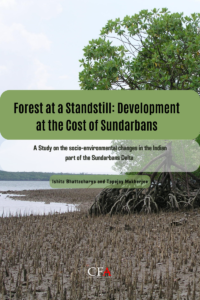A Study on the socio-environmental changes in the Indian part of the Sundarbans Delta
 Deemed as a “World Heritage”, by the United Nations Educational, Scientific and Cultural Organization (UNESCO) – Sundarbans is one of the world’s richest biodiversity hotspots. The region, with arguably the world’s largest remaining area of mangroves, does not just support human settlements and houses a wide variety of flora, diverse fauna and rich aquatic life but is also a breeding ground for several globally threatened species, including the endangered Ganges River dolphin, the masked finfoot, the water bird, the Bengal tiger and various other species of reptiles. About 40 per cent of the nearly 10,000 square kilometres (sq km) of the Sundarbans Forest lies within West Bengal, and the rest in Bangladesh.
Deemed as a “World Heritage”, by the United Nations Educational, Scientific and Cultural Organization (UNESCO) – Sundarbans is one of the world’s richest biodiversity hotspots. The region, with arguably the world’s largest remaining area of mangroves, does not just support human settlements and houses a wide variety of flora, diverse fauna and rich aquatic life but is also a breeding ground for several globally threatened species, including the endangered Ganges River dolphin, the masked finfoot, the water bird, the Bengal tiger and various other species of reptiles. About 40 per cent of the nearly 10,000 square kilometres (sq km) of the Sundarbans Forest lies within West Bengal, and the rest in Bangladesh.
The Sundarbans’ Forest forms a natural barrier, protecting around 14 million inhabitants of the Kolkata Metropolitan Region and other human settlements from cyclones, rising sea tides, and other adverse natural events. The forest ecosystem is also a major source of livelihood and contributes directly to the well-being, and cultural and life support functions of the inhabitants of the area (Uddin et al., 2013; Shameem et al., 2014). Lower rates of literacy and severe poverty leave the residents of the region heavily dependent on the mangrove forests and their ecosystem services. This dependence further creates a close relationship between these inhabitants and the Sundarbans, which is clearly reflected in the local culture through their songs, art, religions and myths.
Unfortunately, despite the Sundarbans Mangroves (Tidal forests) being declared as a protected area and a World Heritage Site in 1997 by the International Union for Conservation of Nature (IUCN) and the United Nations Educational, Scientific and Cultural Organization (UNESCO), its ecosystem is in a very critical condition and is declining at an alarming rate. The decline can be attributed to a range of deforestation drivers due to climatic factors, biological invasions, and illegal human interventions (Iqbal, 2020). Furthermore, climate change, increasing weather variability and extreme weather conditions are likely to increase the vulnerability of the region and amplify the impacts on the dependent poor inhabitants.
The inhabited portions of India’s Sundarbans are also characterized by severe poverty, with dismal living standards. An average of 43.5% of the population lives below the nationally designated poverty line. Inaccessible and hostile terrain conditions, ecological degradation and persisting natural calamities such as cyclones, tidal surges and floods are some of the challenges that the people face continuously (Shaw et. al., 2014). The Sundarbans faces severe floods, almost every year and as a result, its existing water resources remain out of use for several months, certain areas lack infrastructure even for basic amenities; since the super-cyclone Aila of 2009, agriculture remains difficult and unavailing, and yet people’s dependence on the same remains high due to lack of other alternatives.
The study, in this context, aims to further explore and understand the larger socio-environmental changes and the various socio-economic problems faced by the people in Sundarbans due to environmental degradation and climate change.
Read and download the resource here: Forest at a Standstill Development at the Cost of Sundarbans A Study on the socio-environmental changes in the Indian part of the Sundarbans Delta.
Centre for Financial Accountability is now on Telegram. Click here to join our Telegram channel and stay tuned to the latest updates and insights on the economy and finance.
